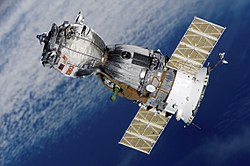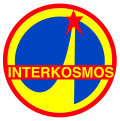 Soyuz 40 is launched from the Baikonur Cosmodrome on 14 May 1981. | |
| Operator | Soviet space program |
|---|---|
| COSPAR ID | 1981-042A |
| SATCAT no. | 12454 |
| Mission duration | 7 days, 20 hours and 41 minutes |
| Orbits completed | 124 |
| Spacecraft properties | |
| Spacecraft type | Soyuz 7K-T |
| Manufacturer | NPO Energia |
| Launch mass | 6,800 kilograms (15,000 lb) |
| Crew | |
| Crew size | 2 |
| Members | Leonid Popov Dumitru Prunariu |
| Callsign | Dnieper |
| Start of mission | |
| Launch date | 14 May 1981, 17:16:38 UTC |
| Rocket | Soyuz-U |
| Launch site | Baikonur 1/5 |
| End of mission | |
| Landing date | 22 May 1981, 13:58:30 UTC |
| Landing site | 225 km SE of Dzhezkazgan |
| Orbital parameters | |
| Reference system | Geocentric |
| Regime | Low Earth |
| Perigee altitude | 198.1 kilometres (123.1 mi) |
| Apogee altitude | 287 kilometres (178 mi) |
| Inclination | 51.6 degrees |
| Period | 89.6 minutes |
| Docking with Salyut 6 | |
| Docking date | 15 May 1981, 18:50 UTC |
| Undocking date | 22 May 1981, 10:37 UTC |
| Time docked | 6 days, 15 hours and 47 minutes |
  L-R: Popov and Prunariu | |
The Soyuz 40 mission was a 1981 Soviet crewed spaceflight and the final flight of the Soyuz 7K-T spacecraft. It was a collaboration between the Soviet Union and Romania. [1]

